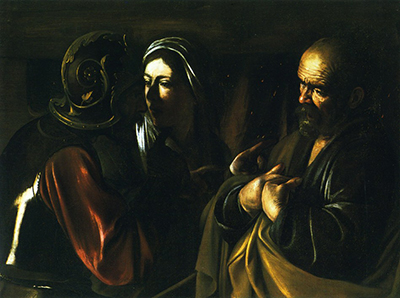 Buy Art Prints Now
Buy Art Prints Nowfrom Amazon
* As an Amazon Associate, and partner with Google Adsense and Ezoic, I earn from qualifying purchases.
Nobody knows the precise date that Caravaggio painted The Denial of Saint Peter.
But, judging by its composition and style, experts believe that he finished it in 1610, the year of his death. It's one of the master's two final paintings, along with the Martyrdom of Saint Ursula.
Caravaggio shows a biblical scene in The Denial of Saint Peter. Peter stands in front of a fireplace while both a serving maid, of the Jewish high priest Caiaphas, and a Roman soldier accuse him of being one of Christ's disciples. Peter adopts a posture and expression of innocence.
This is a scene in the gospels where Peter denies Christ three times. Caravaggio underlines this allusion by the three fingers Peter's accusers point towards him: two from the maid and one from the soldier.
Like Caravaggio's other late works, The Denial of Saint Peter uses the sharp contrast between dark backgrounds and bright lights to add drama to the picture. Rembrandt van Rijn would use a similar approach.
When he first arrived in Rome, Caravaggio conformed more closely to the lighter style of the time, which gave greater attention to detail in the scenery. As he came into his own, he favoured deepening the shadows while picking out the human interaction in bright light. This brought a gritty realism and drama to his works, which often got him into trouble with religious authorities.
He used the technique to full effect in The Denial of Saint Peter. Peter is bathed in light, drawing the viewer's eye, while his two accusers stand in greater amounts of shadow. Peter's dilemma and his denial are the subjects of the painting and the viewer feels this instinctively.
While Caravaggio favoured light sources outside the composition in previous works, he chose a fireplace in this one. Perhaps his intention was to make this a closer, more intimate and human scene so that viewers could more easily imagine themselves in the charged atmosphere of the situation. A huddle of conversation by firelight is something that would have been intensely familiar to audiences of bygone days.
Caravaggio was attacked by several men in a tavern in 1609, the year before experts believe he finished The Denial of Saint Peter. Unfortunately, he never fully recovered from his injuries.
He seems to have had some trouble painting fine detail after the attack, which could be why he took the unusual step of painting a close up scene of the three main characters. He usually took a wider angle in his paintings, but this close scene allowed him to avoid painting fiddly details on background characters and objects.
Adding weight to the theory that he was having trouble with his brushwork, experts point out the broad brushstrokes he used in The Denial of Saint Peter. This suggests he had trouble with his fine motor skills and was unable to grip smaller brushes well, if only for extended periods.
The Denial of Saint Peter inspired a slew of copycat works. The most notable of these is Denial of Saint Peter by José de Ribera.



